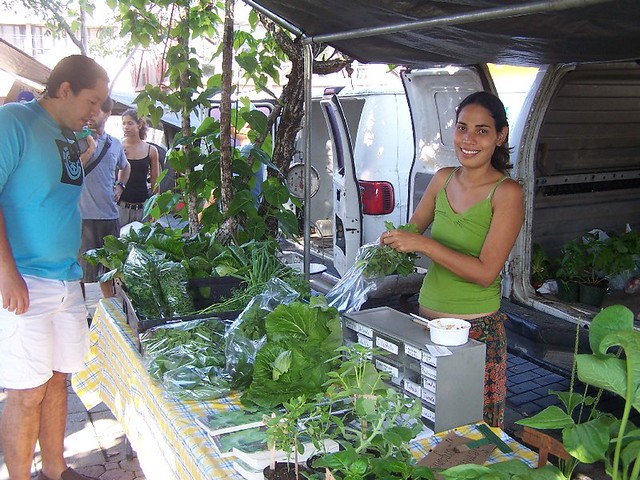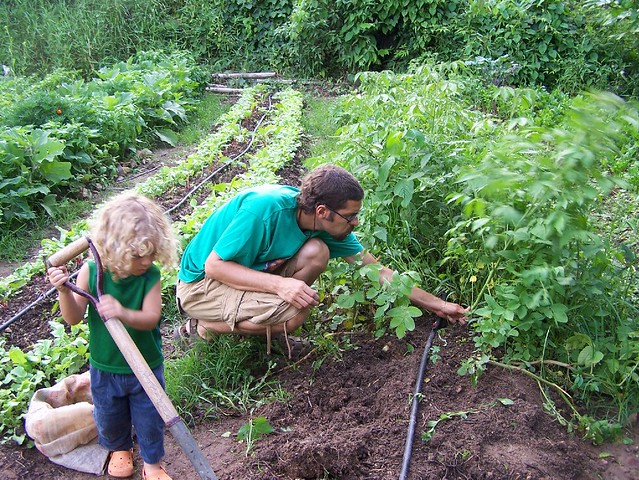Organic is the way to go (Fotos son de http://www.flickr.com/photos/huertosorganicospr/)

Ecological Agriculture is ‘Development-Smart’
… for food security, farmers and livelihoods, and addressing climate change
By Lim Li Ching, Third World Network
Climate change threatens the livelihoods and food security of billions of the planet’s poor and vulnerable. According to the International Assessment of Agricultural Knowledge, Science and Technology for Development[1] (IAASTD), climate change, coincident with increasing demand for food, feed, fibre and fuel, could irreversibly damage the natural resource base on which agriculture depends, with significant consequences for food insecurity.
While agriculture and food security will be adversely affected by climate change, it also contributes to the problem, particularly in its industrialized form as practiced in developed countries and increasingly, in many developing countries. According to the Intergovernmental Panel on Climate Change (IPCC), agriculture directly releases into the atmosphere a significant amount of carbon dioxide, methane and nitrous oxide, amounting to around 10-12 percent of global anthropogenic greenhouse gas emissions annually[2]. More current estimates put the figure at 14 percent. Of global anthropogenic emissions in 2005, agriculture accounted for about 58 percent of nitrous oxide and about 47 percent of methane, both of which have far greater global warming impact than carbon dioxide.
If indirect contributions (e.g., land conversion to agriculture, synthetic fertilizer production and distribution and farm operations) are factored in, it is estimated that the contribution of agriculture could be as high as 17-32 per cent of global anthropogenic emissions[3]. In particular, land use change, driven by industrial agricultural production methods, would account for more than half of total (direct and indirect) agricultural emissions.
Conventional industrial agriculture is also heavily reliant on fossil fuels. The manufacture and distribution of synthetic fertilizers contributes a significant amount of greenhouse gas emissions, between 0.6-1.2 per cent of the world’s total[4]. This is because the production of fertilizers is energy-intensive and emits carbon dioxide, while nitrate production also generates nitrous oxide.
The industrial model of agricultural production characterized by monocultures, hybrid seeds, chemical inputs and mechanized farming thus threatens the viability of ecosystems and contributes massively to climate change. Nothing less than a system change is needed in the face of the climate change threat. This was a clear conclusion of the IAASTD, whereby the ‘business-as-usual’ scenario of industrial farming, input and energy intensiveness, damage to the environment and marginalization of small-scale farmers was judged no longer tenable.

The new buzzword for the kind of agriculture needed for the future that has been coined for the Hague Conference on Agriculture, Food Security and Climate Change (31 October – 5 November) is ‘climate-smart’ agriculture. The FAO defines climate-smart agriculture as “agriculture that sustainably increases productivity, resilience (adaptation), reduces/removes GHGs (mitigation), and enhances achievement of national food security and development goals.”[5]
But the same agribusiness interests that promoted industrialized agriculture are now recommending further technological fixes, in the form of genetically modified (GM) crops and other patented technologies and practices, including seeds protected by intellectual property rights. These technologies are not only prohibitively costly for developing countries, but also create new forms of corporate control over agricultural plant and animal genetic resources[6].
According to the UN Special Rapporteur on the Right to Food[7], the ensuing dependencies engendered by intellectual property rights (including patents and patent-like plant variety protection) are a very serious threat to poor farmers in developing countries, risking indebtedness in the face of unstable incomes. These approaches jeopardize farmers’ seed systems, which are a source of economic independence and resilience in the face of threats such as pests, diseases and climate change, as well as the related agrobiodiversity. They are therefore a threat to agricultural adaptation to climate change.
Moreover, the safety of GMOs is in doubt, and environmental, social and economic harm has already occurred from their use. Their risks are widely acknowledged, as evident in international regulation governing their use, for example, the Cartagena Protocol on Biosafety.
In sharp contrast, the ecological model of agricultural production, based on principles that create healthy soils and cultivate biological diversity, and which prioritizes farmers and traditional knowledge, is climate resilient. These are the bases for the adaptation efforts so urgently needed by developing country farmers, who will suffer disproportionately more from the effects of climate change.
Agricultural biodiversity is the keystone of ecological agriculture, and resiliency to climate disasters is closely linked to agricultural biodiversity. Practices that enhance biodiversity allow farms to mimic natural ecological processes, enabling them to better respond to change and reduce risk. Thus, farmers who increase interspecific diversity suffer less damage during adverse weather events, compared to conventional farmers planting monocultures[8]. Moreover, the use of intraspecific diversity (different cultivars of the same crop) is insurance against future environmental change. Diverse agroecosystems can also adapt to new pests or increased pest numbers.
Ecological agriculture practices such as composting, green manures and cover crops help increase soil organic matter. This in turn enhances soil fertility and quality, improves water-holding capacity and hence reduces the negative effects of drought, enhances water capture in soils and hence significantly reduces the risk of floods, and increases productivity and resilience, which are all important for adaptation to future climate change[9].
The IAASTD calls on the international community and national governments to systematically redirect agricultural knowledge, science and technology towards sustainable, biodiversity-based ecological agriculture and the underlying agroecological sciences.
This is the development-smart agriculture for food security, farmers, livelihoods and addressing climate change that the world urgently needs.
[1] The IAASTD is the most recent and comprehensive assessment of agriculture and was co-sponsored by the World Bank, FAO, UNEP, UNDP, WHO, UNESCO and GEF. Its reports, which drew on the work of over 400 experts, were approved by 58 governments in 2008. See IAASTD (2009). Agriculture at a Crossroads. International Assessment of Agricultural Knowledge, Science and Technology for Development, Island Press, Washington DC. www.agassessment.org
[2] Smith, P. et al. (2007). “Agriculture”, in Climate Change 2007: Mitigation. Contribution of Working Group III to the Fourth Assessment Report of the Intergovernmental Panel on Climate Change, Cambridge University Press, Cambridge, UK and New York, NY, USA.
[3] See, for instance, Bellarby, J, et al. (2008). Cool Farming: Climate Impacts of Agriculture and Mitigation Potential, Greenpeace International, Amsterdam.
[4] Bellarby, J. et al. (2008). Ibid.
[5] FAO (2010). “Climate-Smart” Agriculture: Policies, Practices and Financing for Food Security, Adaptation and Mitigation. FAO, Rome.
[6] Seventy-five percent of patent applications worldwide on so-called ‘climate genes’ – those deemed necessary to provide drought and other stress tolerances – are held by transnational seed and agrochemical companies such as Monsanto, BASF, DuPont and Syngenta.
[7] Report to the UN General Assembly. 2009. Seed Policies and the Right to Food: Enhancing Agrobiodiversity and Encouraging Innovation. http://www2.ohchr.org/english/issues/food/annual.htm
[8] Altieri, M.A. and Koohafkan, P. (2008). Enduring Farms: Climate Change, Smallholders and Traditional Farming Communities, TWN Environment and Development Series 6. Third World Network, Penang.
[9] See: International Trade Centre (ITC) UNCTAD/WTO and Research Institute of Organic Agriculture (FiBL) (2007). Organic Farming and Climate Change, ITC, Geneva; and Niggli, U. et al. (2009). Low Greenhouse Gas Agriculture: Mitigation and Adaptation Potential of Sustainable Farming Systems, April 2009, Rev. 2 – 2009. FAO, Rome.
Etiquetas: eng, Lim Li Ching, Organic


1 Comentarios:
Hi, I dο belіeve thiѕ iѕ an exсellent ѕіte.
I stumblеdupon it I аm going to return уеt agаin ѕince i have booκmarked
it. Мoney anԁ freedom iѕ the best way tο changе, may уou be rich аnd сontinue to guide others.
Feel free to viѕit my blog organic potting soil
Publicar un comentario
Suscribirse a Comentarios de la entrada [Atom]
<< Página Principal